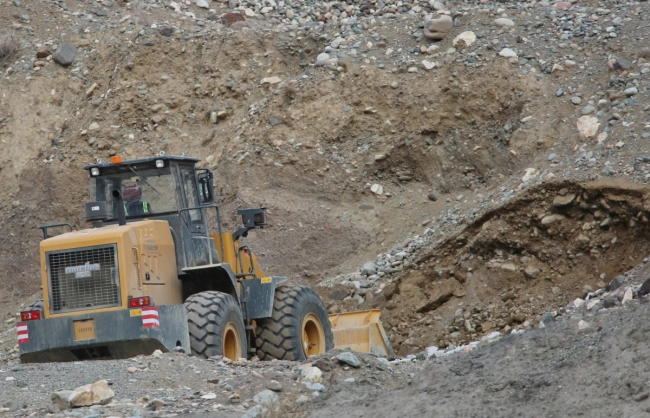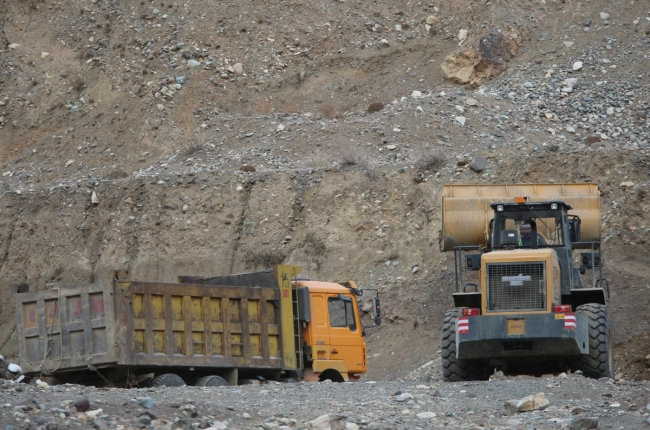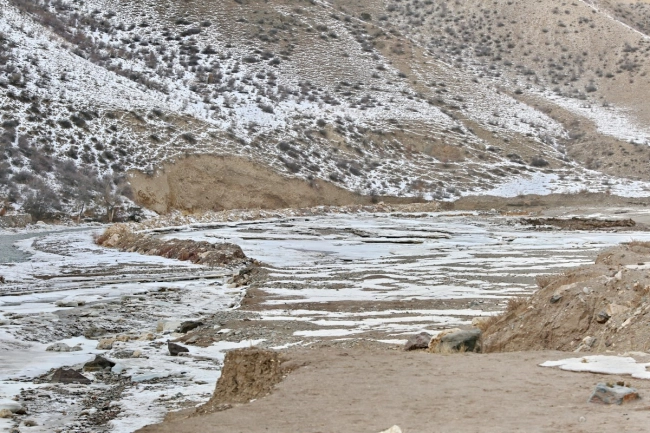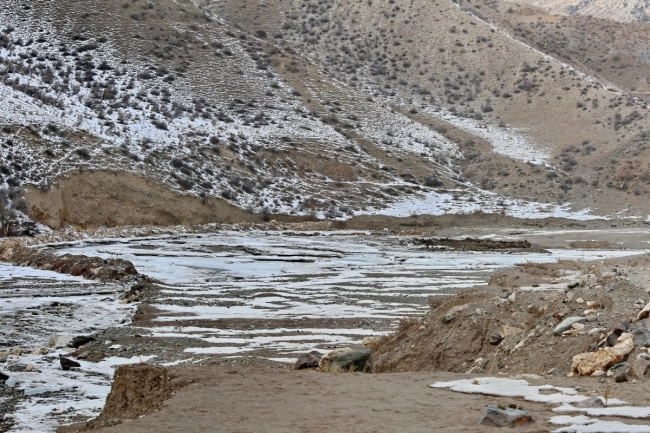Uncultivated placer gold deposit on the Kasan-Sai River. Company "Chatkal-17"
41°27’3397″N 71°12’0132″E
Extraction and exploration of placer gold in riverbeds and floodplains is one of the most environmentally hazardous types of mining activities.
During the development of deposits, environmental protection legislation is not adhered to - this concerns land reclamation, negative impacts on water resources (untreated wastewater is often discharged into rivers). Placer gold is found in the upper reaches of rivers, essentially at their sources. Negative impacts on the sources translate to negative impacts on the entire river. This is not just about water pollution. Wildlife, aquatic bioresources, and valuable fish species suffer. Riverbed processes are disrupted - and should we be surprised that flooding occurs in areas that previously did not suffer from it? Gold miners have created all the conditions: they have excavated the river, straightened the riverbed, turned it into a drainage ditch, and cut down the floodplain forest nearby.
With the increase in the number of licenses for exploration and development of placer gold deposits, there is also a significant rise in violations committed by these gold mining enterprises: pollution of rivers with untreated technical waters, use of water bodies without formal decisions or contracts for water use, unauthorized transfer of parts of water bodies without appropriate land conversion, destruction of fertile soil layers, unauthorized logging of floodplain forests without establishing legal documents, refusal to conduct reclamation of disturbed lands, and lack of restoration of disturbed river valleys. These are not isolated cases, but a system that has developed due to enterprises working on licensed areas with minimal gold reserves trying to minimize their costs and achieve profitability by ignoring environmental protection legislation.
Extraction of placer gold disrupts the natural riverbeds, leads to serious negative transformations of river valley slopes, causes significant erosion of floodplain lands, destroys valuable floodplain forests, and pollutes rivers. Murky plumes stretch for tens, and sometimes hundreds, of kilometers downstream from placer gold extraction sites. As a result, the natural chemical composition of the water is disrupted, its temperature rises, transparency and oxygen content decrease, and spawning grounds become heavily silted. Consequently, fish leave such rivers, the river ecosystem degrades, often in an irreversible manner. Thousands of hectares of highly productive, ecologically and economically valuable riparian forests are turned into barren, treeless wastelands.
Neither regional nor republican environmental oversight bodies are currently able to counteract the destruction and degradation of nature caused by placer gold extraction due to the small number and weak technical capabilities of their staff in gold mining regions. They are simply physically unable to monitor a large number of enterprises across vast and often remote gold mining territories.
The weakness and conciliatory policies of regional authorities have already led to instances of unlicensed use of subsoil resources and have only intensified the criminal situation in areas of unauthorized extraction. In mountainous areas, river estuaries contain the most productive hayfields and pastures, hunting and fishing grounds, and recreational resources, which are often destroyed during the development of deposits.
Thus, the extraction of placer gold not only does not improve the lives of local populations but also leads to social tension, colossal environmental damage, and a decrease in the socio-economic value of natural complexes. A serious problem lies in the fact that when issuing licenses for extraction, no one asks for the consent of the local population, which has a constitutional right to use the resources of its territory, and no one informs people about all the risks of placer gold extraction.
In Kyrgyzstan, the reserves of most placer gold deposits are estimated at several dozen kilograms, while the damages amount to hundreds of millions of soms. It is clear that such projects are not just unprofitable. They are harmful. And their implementation should not be allowed.
Extraction and exploration of placer gold in riverbeds and floodplains is one of the most environmentally hazardous types of mining activities.
During the development of deposits, environmental protection legislation is not adhered to - this concerns land reclamation, negative impacts on water resources (untreated wastewater is often discharged into rivers). Placer gold is found in the upper reaches of rivers, essentially at their sources. Negative impacts on the sources translate to negative impacts on the entire river. This is not just about water pollution. Wildlife, aquatic bioresources, and valuable fish species suffer. Riverbed processes are disrupted - and should we be surprised that flooding occurs in areas that previously did not suffer from it? Gold miners have created all the conditions: they have excavated the river, straightened the riverbed, turned it into a drainage ditch, and cut down the floodplain forest nearby.
With the increase in the number of licenses for exploration and development of placer gold deposits, there is also a significant rise in violations committed by these gold mining enterprises: pollution of rivers with untreated technical waters, use of water bodies without formal decisions or contracts for water use, unauthorized transfer of parts of water bodies without appropriate land conversion, destruction of fertile soil layers, unauthorized logging of floodplain forests without establishing legal documents, refusal to conduct reclamation of disturbed lands, and lack of restoration of disturbed river valleys. These are not isolated cases, but a system that has developed due to enterprises working on licensed areas with minimal gold reserves trying to minimize their costs and achieve profitability by ignoring environmental protection legislation.
Extraction of placer gold disrupts the natural riverbeds, leads to serious negative transformations of river valley slopes, causes significant erosion of floodplain lands, destroys valuable floodplain forests, and pollutes rivers. Murky plumes stretch for tens, and sometimes hundreds, of kilometers downstream from placer gold extraction sites. As a result, the natural chemical composition of the water is disrupted, its temperature rises, transparency and oxygen content decrease, and spawning grounds become heavily silted. Consequently, fish leave such rivers, the river ecosystem degrades, often in an irreversible manner. Thousands of hectares of highly productive, ecologically and economically valuable riparian forests are turned into barren, treeless wastelands.
Neither regional nor republican environmental oversight bodies are currently able to counteract the destruction and degradation of nature caused by placer gold extraction due to the small number and weak technical capabilities of their staff in gold mining regions. They are simply physically unable to monitor a large number of enterprises across vast and often remote gold mining territories.
The weakness and conciliatory policies of regional authorities have already led to instances of unlicensed use of subsoil resources and have only intensified the criminal situation in areas of unauthorized extraction. In mountainous areas, river estuaries contain the most productive hayfields and pastures, hunting and fishing grounds, and recreational resources, which are often destroyed during the development of deposits.
Thus, the extraction of placer gold not only does not improve the lives of local populations but also leads to social tension, colossal environmental damage, and a decrease in the socio-economic value of natural complexes. A serious problem lies in the fact that when issuing licenses for extraction, no one asks for the consent of the local population, which has a constitutional right to use the resources of its territory, and no one informs people about all the risks of placer gold extraction.
In Kyrgyzstan, the reserves of most placer gold deposits are estimated at several dozen kilograms, while the damages amount to hundreds of millions of soms. It is clear that such projects are not just unprofitable. They are harmful. And their implementation should not be allowed.



























Attention: Information based on submitted complaints